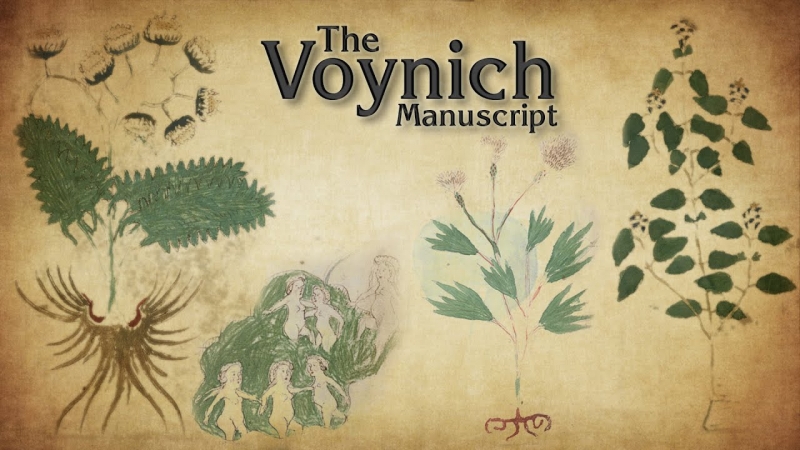
The Voynich manuscript is a longstanding linguistic mystery. Nobody has figured it out yet, what language is this text written in. No matter how hard you try to figure it out, the manuscript did not lend itself. In May of this year, information appeared about a new attempt to decipher the Voynich manuscript., however, it quickly became clear, as this time, Alas, no solution. Linguist Maxim Rousseau disassembles, why the new version is not good, and at the same time talks about, what is proto-Romance language.
AT 1912 Gregorian University in the Vatican was in financial trouble, and the Jesuit order, which runs the university, decided to rectify the situation, selling behind the scenes a number of old books. The buyer was Wilfried Voynich, a London-based bibliophile of Polish origin. (Wilfrid Voynich). Going to Italy, he, undoubtedly, looked forward to interesting acquisitions, but didn't realize, that one of the manuscripts he chose will remain forever associated with his name.
Opening the famous codex, we will see a lot of incomprehensible drawings: plants, nude women in baths, stars, incomprehensible diagrams, vessels. Text next to them. (more 170 thousand. signs, about 35 thousand. words), but he won't make it clear. The alphabet used in the manuscript ("Voynich font") not found in any other document, and we still don't know, what language is the Voynich manuscript written in and what does it say. For more than a hundred years, dozens of people, from amateurs to specialists of the US National Security Agency, unsuccessfully tried to read this text.
This manuscript is now in the Beinecke Rare Book and Manuscript Library at Yale University.. It is small - format 23.5 × 16.2 cm, thickness 5 cm. The manuscript is written on parchment, stitched in 18 notebooks, which in total amount to about 240 pages (the exact amount depends on, how to count some pages, additionally folded horizontally). Some of the owners of the book put down page numbers, and thanks to this it is clear, that previously in the manuscript was at least 20 notebooks and 272 pages.
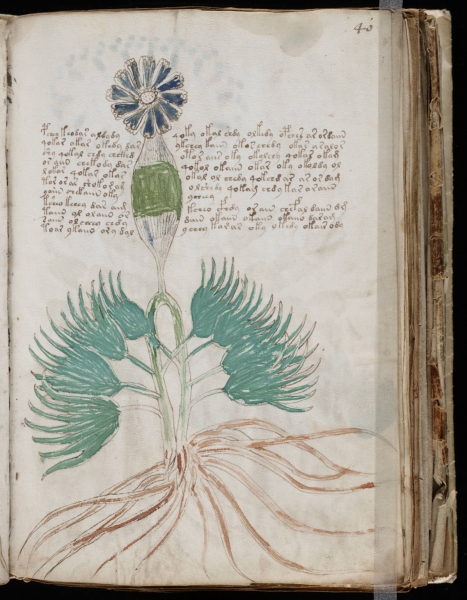
There are many sketches of plants on the pages of the manuscript - perhaps, it's some kind of medicine. But we can hardly find out for sure.
Morning 15 May began for me with the news, that the Voynich manuscript has finally been deciphered. Alas, it became clear pretty quickly, that the sensation did not take place. The proposed hypothesis was not much different from the variants of readings of the Voynich manuscript., appearing about once a year. But the new version managed to get much wider popularity., because the author managed to publish his work in a scientific journal, and the University of Bristol issued a press release on the subject. The press release was included in the leading scientific news aggregators (Eurekalert.org, Phys.org etc. d.), where do the major media get their material for their texts. Publications in the media have become material for news in other publications, and a wave of messages successfully spread around the world.
The current hypothesis is worthy of detailed consideration precisely as a typical attempt to read the Voynich manuscript.. Written by Gerard Cheshire (Gerard Cheshire), biologist and author of a large number of popular science books on a variety of topics, from evolutionary theory to postal history. Cheshire published his article on the Voynich manuscript in the journal Romance Studies [1], specializing in research in the field of culture and literature of the Romanesque peoples. Linguistic papers rarely appear in this journal.. Cheshire previously posted two articles about the Voynich manuscript on a linguistic preprint site. [2, 3].
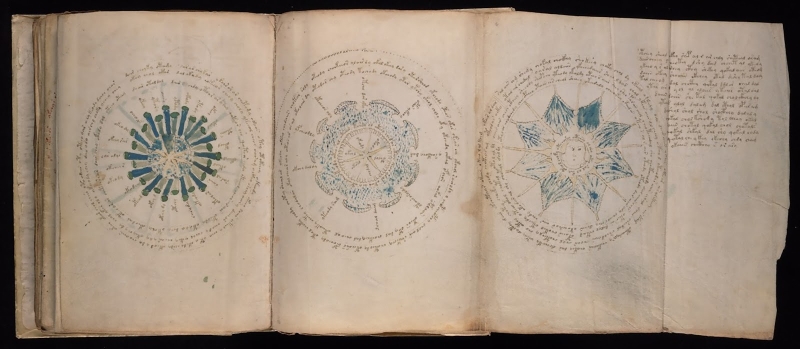
Cheshire approach
Biologist claims, that he was able to establish the meanings of the letters of the Voynich manuscript and read a number of fragments of the text. Cheshire defined the language of this text as "proto-Romance", that is, the ancestor language for the modern languages of the Romance group: Spanish, French, Italian and others. Based on reading the caption to one of the drawings, Cheshire came to the conclusion, that it depicts a map of the Gulf of Naples and a volcanic eruption, what happened there 4 February 1444 of the year. He then concludes, that the manuscript was written on the island of Ischia for Queen Mary of Castile (1401–1448), wife of Alfonso V the Magnanimous (1396–1458), King of Aragon and the Kingdom of Naples. The residence of the royal couple - the so-called Aragonese castle - was located on a small island near Ischia. Voynich manuscript, according to Gerard Cheshire, is kind of like a guide., compiled for the Queen by the nuns and devoted primarily to medicine. This is in good agreement with the previously obtained radiocarbon dating of parchment - 1404-1438. [4].
Gerard Cheshire's approach to text translation is, that he is looking for for each word some similar-sounding analogue in one of the Romance languages, and then from a sequence of such words builds a meaningful sentence or phrase. Wherein Catalan can follow each other in one sentence, Old French, Spanish, Romanian, again Catalan and Portuguese words. No attempts are made to comprehend the reconstructed text as a grammatical structure.. "Proto-Romansh" in the understanding of Cheshire appears as a set of words of Romance origin, without any grammatical indicators, analytic forms of verbs, rules for word order in a sentence, etc..
Similarly, one could declare the language of the Voynich manuscript, eg, pra-Turkic and pick up reading letters like this, so that consecutive words have matches then in Chuvash, it is in Bashkir, then in Yakut, then in the Tuvan language. But how the Proto-Turkic language was not a mixture of words from different Turkic languages, and Proto-Romansh - with a mixture of words from their descendant languages. in front of, a strong resemblance to words from a later era should cause skepticism about the text in the "proto-language": to get your current look, the words of the parent language had to go through a long evolution. And in each descendant language, changes occurred according to their own laws..
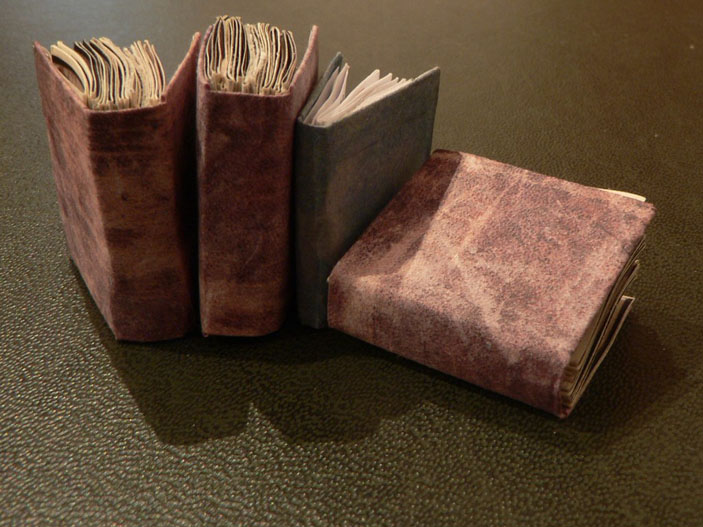
The manuscript was kept in the Vatican and was sold to the bibliophile Voynich by needy Jesuits.. Reproduction: Flickr / lamont_cranston (CC BY-NC-SA 2.0)
The most striking example was the phrase, which Cheshire transliterates as omor néna and translates as ‘dead child’, linking with the Romanian verb omor ‘to kill’ and the Spanish niña ‘girl’. At the same time, the Romanian word omorî ‘to kill’; (omor - first person singular) is actually a Slavic loanword (get tired) [5] and could not get into the language of the document, written in the 15th century far from Romania.
Sometimes, in order to achieve a meaningful translation, one has to use non-obvious meanings of Romance words.. To the list 53 one of the words Cheshire reads as lanasa. He knows the Italian lanoso (‘furry, fluffy'), but this meaning is not suitable for the general context. So he remembers the Spanish word lanas (plural of lana, 'wool'), which in jargon means money, and uses it to translate. of course, there is no evidence, that such a designation of money existed outside of Spain in the 15th century and could be used in a book, destined for the queen.
In addition to the dubiousness of the method, with which Cheshire tries to read the Voynich manuscript, making sentences from sets of words in different Romance languages, there is a serious flaw in his work of the general order. Cheshire calls the language of the manuscript proto-Romance. Links to three works, which he cites at the first mention of this language, leave no doubt, what is meant by the language-ancestor of all Romance languages. In this case, the surprising fact: Proto-Romance text, according to Cheshire, was written in the 15th century.
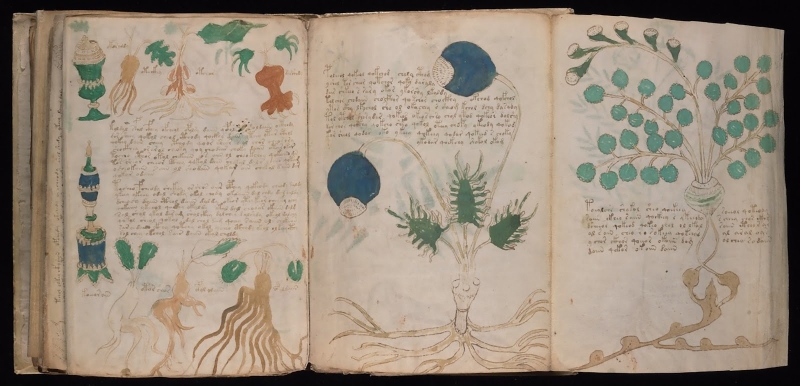
Lame on a chronological foot
Proto-Romance really existed. Most often, the term "folk Latin" is used to refer to it.. Spoken forms of Classical Latin, that existed in different provinces of the Roman Empire, over time, accumulated local features and gradually acquired a written form, and then developed into full-fledged languages.
The chronology of this process is estimated differently.. Most scientists tend to think, that there were serious dialectal differences in the regional variants of folk speech already in the Roman Empire, and by the 6th-7th centuries it was already possible to speak of the existence of separate Romance languages and dialects. There is another view, owned by G. F. Maller [6] and his followers, according to which the unity of the spoken Romance language was preserved until the end of the 8th century thanks to active communication between different regions, and the divergence of the Romance languages began only after the collapse of the power of Charlemagne. But even with this approach,, that by the 9th century the Romance languages were already independent.
Recall, as Cheshire, and other scholars of the Voynich manuscript agree that, that the text was written no earlier than the 15th century. By that time, the history of the main Romance languages had already spanned several centuries.. In the 11th century there was already an extensive literature in Old French. Only a little later developed literary traditions arose in Provençal, Spanish (at least four centers: Castiles, Aragon, Galicia and Catalonia), in different varieties of Italian (in Tuscany, Let's go, Umbria, in Sicily). By the time the Voynich manuscript was created, the Song of Roland already existed., "Song of My Sid", works of Bertrand de Borna, Chrétien de Troyes, Juan Ruiz, Guido Cavalcanti, Petrarch, Boccaccio, Dante and hundreds of less famous authors. Romance languages infiltrated legal documents, gradually replacing classical Latin from there.
And suddenly in the middle of the XV century in the vicinity of Naples, according to Gerard Cheshire, someone writes a whole book in proto-Romance (forget for a second, that the resulting texts have nothing to do with, what do we know about vernacular Latin). The appearance of such a book is just as incredible, as well as writing a book in Proto-Slavic or Proto-Germanic in the same era.
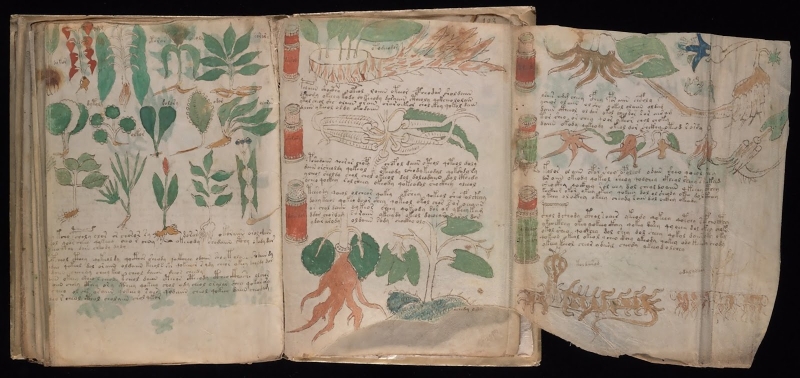
Lingua franca of the mediterranean sea?
Exist, true, another variant, which would explain the appearance in the 15th century of the text, similar to several Romance languages at once. It's about sabir, or "Mediterranean lingua franca", originated around the 11th century and existed for several centuries. He was a pidgin in Romance (predominantly Italian) lexical basis and was used as an intermediary language in the communication of European sailors and merchants with the Arabs and later the Turks in the Mediterranean.
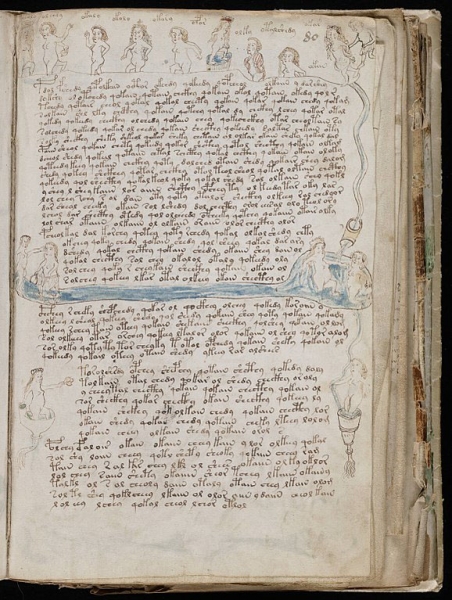
The text of the document remains a mystery to linguists. May be, there were trolls in the 15th century too?
One of Cheshire's places of work uses the words lingua franca, but not completely clear, whether he uses them to refer to a Mediterranean medieval pidgin or as a term, denoting an intermediary language, which is not native to any of the speakers (in this sense, the term "lingua franca" is used in sociolinguistics). But Cheshire in any case insists on the proto-Romance character of the language of the Voynich manuscript., and sabir was not at all like folk Latin. One version rules out the other. According to the list of literature used by him, Cheshire did not refer to any study of the sabir, and the readings he offers do not contain anything like sabir.
Among the captions he read to the drawings of the Voynich manuscript, Cheshire also mentions the names of the months, accompanying drawings of zodiac signs. But this is not his achievement.. They, along with a few more lines, not written in Voynich script, and medieval Latin, known for a long time. true, still unclear, whether they were written at the same time as the main text or added to the book later.
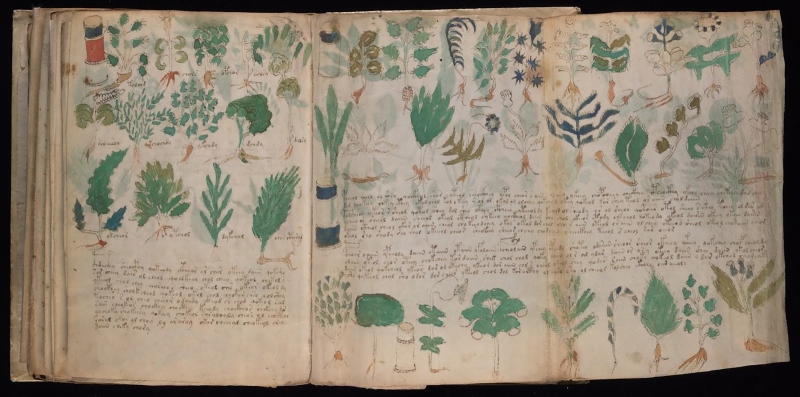
How the Voynich manuscript was read
Previously, the Voynich manuscript was tried to be read in Old Welsh, Manchu, "unknown North German dialect", Middle German, Hebrew, Chinese, Old Spanish, Old Dutch, Old Ottoman, Arabic, Latin [10], "Creole language based on Flemish" [11] and Nahuatl [12]. And that's not counting the very anecdotal attempts, like a message, as if in the Voynich manuscript the text in Ukrainian was written in an artificial alphabet, and without vowels - this was stated in the book "Letter to the Eye of God" by John Stoiko, which made a lot of noise among the Ukrainian diaspora in the United States in the late 1970s [13, 14]. Previous attempt, made in 2016 year and spread in the media at the beginning 2018 of the year, included the use of artificial intelligence and was published in the journal Computational Linguistics (Transactions of the Association for Computational Linguistics, [15]). In that version of deciphering, the laws of the development of languages and banal chronology were ignored in the same way..
If the authors of the hypothesis retain common sense and do not indulge in fantasies, then they can usually produce readings of only individual words and phrases from the Voynich manuscript. unsurprisingly, because the volume of text is quite large, and with a certain diligence in it you can pick up a line or several, fit perfectly into the text in the selected language. It remains only to replace the letters of the "Voynich font" with the necessary.
Therefore, there is no need to rush to rejoice, having heard another message about deciphering the manuscript. The hypothesis will be worthy of attention only if, when its author can read at least several consecutive sentences, and this reading will not be a set of words, receiving meaning only in the mouth of the interpreter, but in coherent text in the corresponding language. But all this will be true provided, that the Voynich manuscript is indeed a natural language text, and not a hoax by an unknown author of the 15th century, depicting fantastic letters next to no less fantastic drawings.
literature:
1. Cheshire G. The Language and Writing System of MS408 (Voynich) Explained // Romance Studies, DOI: 10.1080/2639904.2019.1599566.
2. Cheshire G. Linguistic Missing Links.
3. Cheshire G. Linguistically Dating and Locating Manuscript MS408.
4. Daniel Stolte. UA Experts Determine Age of Book ‘Nobody Can Read’ // UANews, 9.02.2011.
5. Ciorănescu A. Etymological dictionary of the Romanian language. Bucharest. 2007. P. 560.
6. Muller H. F. A chronology of vulgar Latin. Hildesheim, 1970 (first edition Halle, 1929).
7. Dictionary of the Frankish or Little Moorish language followed by some familiar dialogues and a vocabulary of the most common Arabic words. For the use of the French in Africa. Marseille. 1830.
8. A Glossary of Lingua Franca. Fifth edition. Ed. Alan D. Corré. 2005.
9. Whinnom K. Lingua franca. Historical problems // A. Valdman and A. Highfild (eds.) Pidgin and creol linguistics. New York. P. 295–310.
10. Voynich Theories // Cipher Mysteries.
11. Levitov L. Solution of the Voynich Manuscript: A Liturgical Manual for the Endura Rite of the Cathari Heresy, the Cult of Isis. 1987. Laguna Hills, California: Aegean Park Press.
12. Tucker A. O., Talbert R. H. A Preliminary Analysis of the Botany, Zoology, and Mineralogy of the Voynich Manuscript // HerbalGram. The Journal of the American Botanical Council. 2013. 100. P. 70–75.
13. Stojko J. Letters to God’s Eye: The Voynich Manuscript for the first time deciphered and translated into English. 1978. New York: Vantage Press.
14. Rusina O. To the "impossible sources" of national history: "The Voynich Manuscript" in the Ukrainian context // Harvard Ukrainian Studies. Vol. 32–33 (2011–2014). Part 2. P. 611–618.
15. Transactions of the Association for Computational Linguistics. Vol. 4. P. 75–86, 2016.











